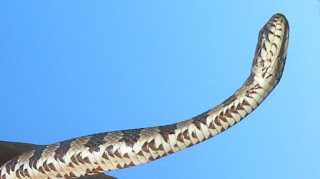I'll cover Kingsnakes and Pit Vipers in another post, but for now here are some of the snakes I've found in Missouri.
First, I'll cover milksnakes. These beautiful snakes are plentiful and not overly difficult to find. Look for them under rocks, stones, and boards in open glades, fields, or the edges of forests where the sun can warm these objects up.
The western ribbon snake is beautiful snake. They are not uncommon but I found less of them than many other species, possibly in part because I tend to search in the fields and glades and these snakes are probably more common in wetter areas but expect to come across one from time to time anyway.
Garter snakes are quite common, probably more so near water but they can turn up anywhere. I enjoy seeing these snakes especially when they have a lot of red coloration.
The eastern hognose is a strange snake. They can show up in a lot of places but determining when you will see one is tricky. There are some places they are more likely to be found than others, but even then it's a mystery when the next one will turn up, sometimes under cover, sometimes on the crawl. There may be more reliable places to find them, but in the places I searched they were rare to find (I don't believe they are actually rare per se (and they have many localities that I am aware of) but due to the borrowing habits, I think they are just not as easy to find.)
Earthsnakes, much like the wormsnake, seem more shade tolerant than many other snakes and can sometimes be found under cover even in shadier areas.
I did not find the flathead snake in many locations. It could be that it's just not that numerous in the particular locations I was looking. It is an interesting snake but quite small.
I also did not find that many red bellied snakes. I found it in more than one location but I just didn't find many of them in total. I found some under cover typical cover objects and I found some under piles of mowed grass next to a prairie at the edge of a woods.
The lined snake is numerous where it occurs, but there were many locations I searched and did not find lined snakes. I would describe them as common where they occur, but don't expect to find them at every location by any means.
The plainbelly watersnake is also called the yellowbelly watersnake. The pictures below should explain the name.
The most common and widespread watersnake species is the Northern Watersnake.
Black ratsnakes are a large and attractive species that I have found crossing roads, under boards in weedy fields, in hollow logs, and high in trees in densely forested areas. They can turn up almost anywhere.
The foxsnake occurs further north in the state than I spent most of my time looking. It is therefore not possible for me to have an opinion on how common or not this snake might be. I was able to turn up a couple of them though and really enjoyed finding this species. It took several attempts searching for the snakes before I found them. I spoke with another competent snake hunter who also made a few searches and at the time we last spoke he had not yet found one.





































Comments
Post a Comment